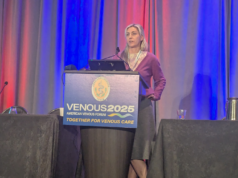
A retrospective review of patients presenting with bilateral obstructive iliofemoral venous lesions has shown that contralateral limb symptoms improve following stenting of the worse ipsilateral limb. In addition to this, the study found that only a small proportion of patients needed to undergo stenting during follow up, because of their clinical situation becoming worse or due to lack of relief.
The results of the review, presented at the annual meeting of the American Venous Forum (VENOUS 2020; 3–6 March, Amelia Island, USA) by Arjun Jayaraj (The RANE Center, Jackson, USA), suggest the need for a staged approach to iliofemoral venous stenting with a greater initial focus on the more symptomatic limb.
Introducing the study, Jayaraj asserted that symptoms of chronic venous insufficiency, secondary to obstructive iliofemoral disease, are often bilateral. Furthermore, the impact of stenting the more symptomatic lower extremity, upon clinical outcomes of the less affected, remains uncertain.
With regards to the retrospective review, Jayaraj and colleagues aimed to determine whether the possible benefits of stenting the worst-affected ipsilateral limb could be great enough to prevent the contralateral extremity from requiring intervention.
To examine this possibility, electronic medical record data of 368 patients/limbs who received initial unilateral iliocaval stents between 2015 and 2017, were analysed. Excluded from the study were patients who underwent simultaneous bilateral stenting, or were diagnosed with occlusive disease.
For the remaining patients, the impact of stenting on contralateral leg symptoms was evaluated using a number of tools: the visual analogue scale (VAS) pain score (1–10); grade of swelling (0–3); and the Venous Clinical Severity Score (VCSS). To assess stent patency following intervention, a Kaplan-Meier analysis was used, while paired t-tests were employed for the purposes of examining clinical outcomes.
Expanding on the demographics of the cohort studied, Jayaraj explained that out of 368 limbs that underwent stenting for stenotic lesions, 304 (83%) had contralateral symptoms. In 229 of these limbs, the cause was post-thrombotic syndrome; for the other 75 limbs, these symptoms were the result of May-Thurner syndrome/non-thrombotic iliac vein lesions. “The median age of these patients was 63 years, and there was preponderance of women,” he added.
After stenting of the ipsilateral side, the VAS pain score improved, on average, from 5 to 0 for patients in the contralateral group (p<0.0001), while the grade of swelling decreased from 3 to 1 (p<0.0001) and the VCSS fell from 5 to 3 (p<0.0001).
During the median follow up of 20 months, 15 contralateral limbs (5%) underwent stenting. Among these patients, the median VAS pain score, grade of swelling and VCSS score were 6.5, 2 and 5, respectively, compared with 0 (p>0.0001), 1 (p>0.27) and 3 (p=0.0021) in those from the contralateral cohort who did not require stenting.
Finally, the speaker noted that primary and primary-assisted patencies, at 12 months following contralateral stenting, were 75% and 100% respectively with no stent occlusions occurring after contralateral stenting. “While the prevalence of contralateral symptoms following iliocaval stenting is quite high, only 5% of such patients require stenting of the contralateral leg, resulting from either an absence of symptom relief or from progression of disease,” Jayaraj noted.
The speaker finished by underscoring how “a wallstent and Z-stent combination seems to do better than the use of a wallstent alone”, and that “outcomes following use of dedicated venous stents remain to be determined”.









